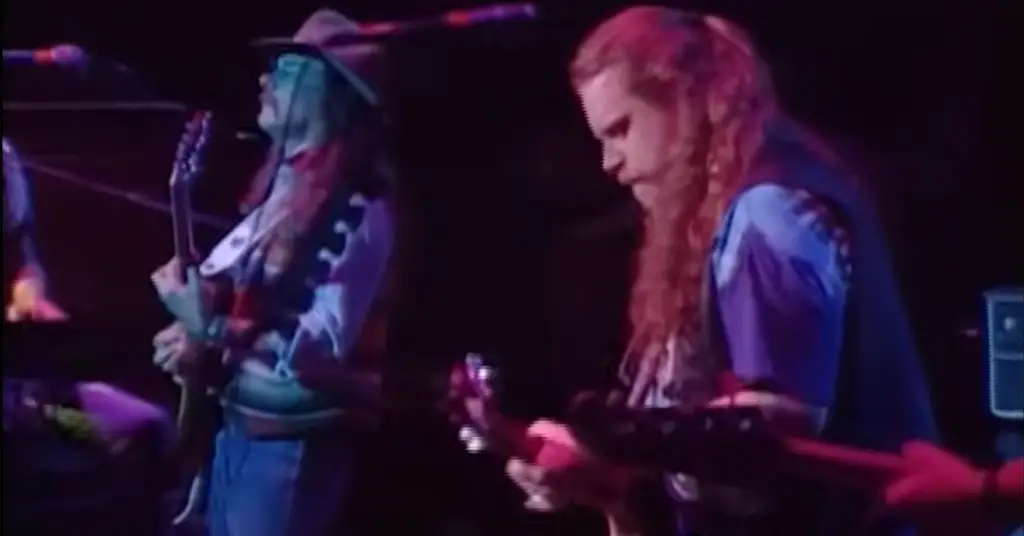The Allman Brothers Band – “Statesboro Blues” (Live at Great Woods 1991): Slide Guitar Glory and Southern Soul Revival
When the Allman Brothers Band took the stage at Great Woods Amphitheater in Mansfield, MA on September 6, 1991, they were in the midst of a triumphant return. After reuniting in 1989 and adding young blood like Warren Haynes and Allen Woody, the band was reinvigorated — and nowhere is that clearer than in this searing performance of “Statesboro Blues.”
Originally a blues standard by Blind Willie McTell, made legendary by the Allmans on their 1971 live album At Fillmore East, “Statesboro Blues” had long been a signature tune. But in this 1991 version, the band honors its roots while reaffirming its future — tighter, meaner, and still dripping with soul.
The History: A Slide Guitar Anthem
“Statesboro Blues” was written in 1928 by Blind Willie McTell, a 12-string bluesman whose influence stretched deep into American roots music. The Allman Brothers’ version, however, is based on Taj Mahal’s 1968 cover, which featured Jesse Ed Davis on slide guitar — a version that deeply inspired Duane Allman.
By the time At Fillmore East was recorded, Duane had transformed the song into a slide guitar showcase, opening shows with a roaring bottleneck tone that became the stuff of legend. Even after Duane’s death, “Statesboro Blues” remained a fiery tribute and foundational piece of the band’s set.
The Great Woods 1991 Lineup: New Blood, Old Soul
This particular performance features:
- Gregg Allman on vocals and organ — the band’s emotional and musical core
- Dickey Betts and Warren Haynes trading blistering guitar licks
- Allen Woody on bass — thunderous and locked-in
- Butch Trucks and Jai Johanny “Jaimoe” Johanson on drums — the legendary double-drummer combo
- Marc Quiñones on percussion — adding Latin spice and depth to the groove
It’s a band that knows its legacy, but isn’t content to rest on it.
The Performance: Raw, Tight, and Electrifying
From the first slashing slide lick, Warren Haynes takes up the mantle once held by Duane and absolutely owns the spotlight. His tone is thick, greasy, and full of fire — a perfect blend of reverence and personal flair.
Highlights include:
- Warren’s ferocious slide intro, faithful to Duane’s phrasing but with his own bite
- Gregg’s soulful, smoky vocals, aging like fine bourbon — weathered but potent
- A locked-in groove from Woody, Trucks, and Jaimoe that gives the song unstoppable momentum
- Betts and Haynes trading solos, creating a conversation between past and future
- A finale that doesn’t just end — it erupts
The energy is undeniable. This isn’t a museum piece — it’s a living, breathing blues explosion.
Why It Matters: A Bridge Between Eras
The Allman Brothers Band of 1991 was at a creative and technical high point. After years of lineup changes, breakups, and tragedy, the group had found a lineup that could reclaim their legacy while still moving forward.
“Statesboro Blues” at Great Woods isn’t just nostalgia. It’s proof that the spirit of Duane, the essence of Southern blues-rock, and the fire of improvisation still burned as hot as ever.
This performance is often held up by fans as one of the great post-reunion versions of the song, a highlight in a setlist full of barn burners.

Final Thoughts
If you ever needed a reason to believe that the Allman Brothers Band were more than a legacy act in the ’90s, “Statesboro Blues” from Great Woods ‘91 is it. It’s a track steeped in history, reborn with new hands, old soul, and relentless swagger.
It’s not just a song — it’s a statement:
The road goes on forever. And the blues? They’re still alive and well.


Facebook Comments